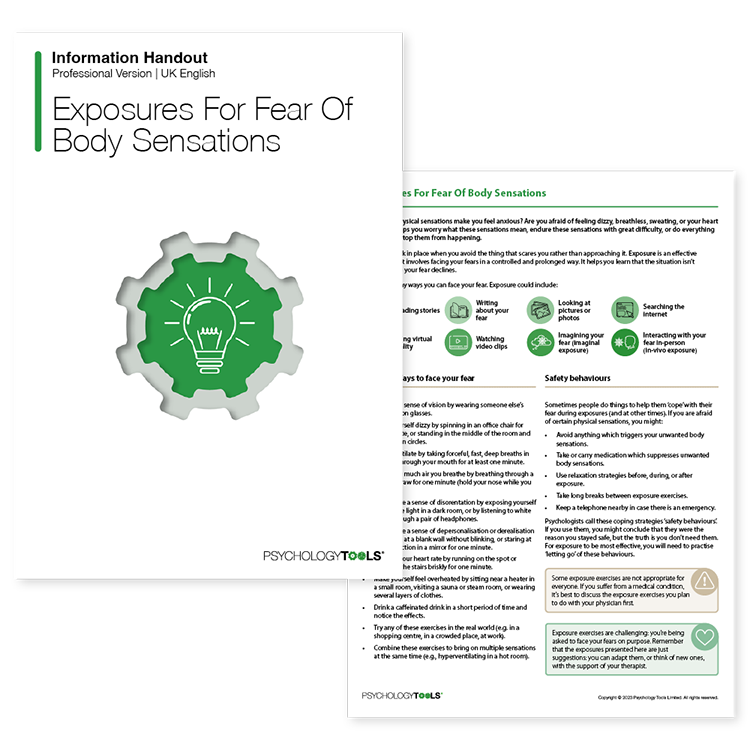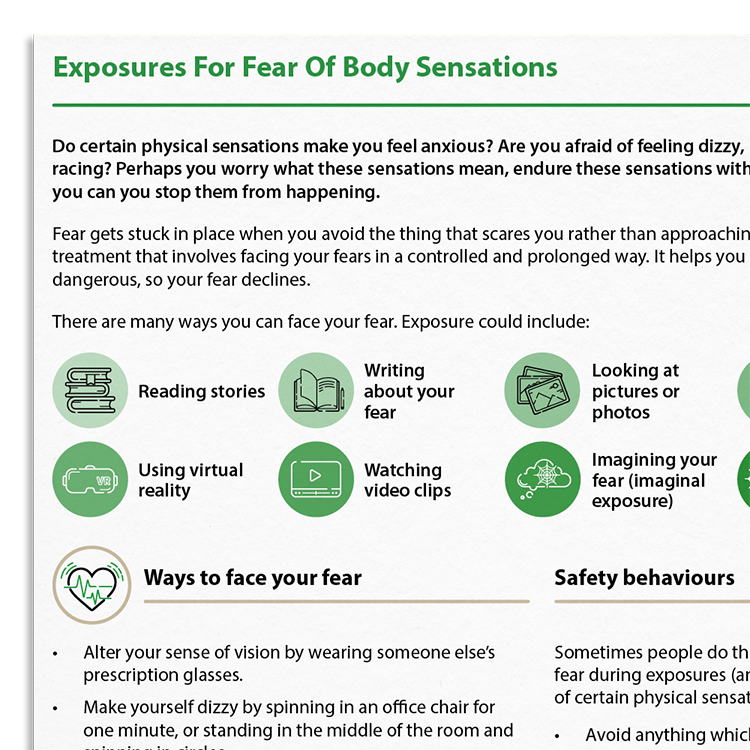Professional version
Offers theory, guidance, and prompts for mental health professionals. Downloads are in Fillable PDF format where appropriate.
The Exposures For Fear of Body Sensations handout helps clients and therapists identify feared stimuli, create exposure hierarchies, and plan exposure exercises and experiments to overcome this fear.

Offers theory, guidance, and prompts for mental health professionals. Downloads are in Fillable PDF format where appropriate.

Fearful responses to physical sensations are common in several disorders. Interoceptive exposure (or ‘symptom induction’) is an effective treatment for these fears, typically preceded by the development of a fear ladder or exposure hierarchy. Clients sometimes find it difficult to develop appropriate exposure tasks or identify manageable ‘steps’ between behavioral experiments.
The Exposures For Fear Of Body Sensations information handout is designed to help clients and therapists identify feared stimuli, develop exposure hierarchies, and plan appropriate exposure exercises and behavioral experiments. It also contains information about safety-seeking behaviors which may need to be addressed during exposure.
Exposure is one of the most effective interventions for overcoming fear. It involves individuals repeatedly facing their fears to reduce their fearful responses and reverse the patterns of avoidance that perpetuate them.
Address physical sensations that trigger health concerns.
Target feared bodily sensations associated with panic attacks.
Facilitate exposure to sensations linked to nausea and vomiting.
Ensure the client relates to the fear described in the handout.
Go over the list of exposures for facing this fear.
Pinpoint specific items that would make the client feel anxious or afraid.
Explore additional scenarios that would make the client fearful.
Specify the safety behaviors the client might use to cope with their fear.
Ensure that the process of exposure is clear and makes sense to the client.
Discuss how the client might begin exposing themselves to their fears.
Exposure is one of the most effective strategies for overcoming fear (Hofmann & Smits, 2008). It involves individuals repeatedly confronting their fears in order to reduce their fearful responses and break the patterns of avoidance that maintain those fears (Springer & Tolin, 2020).
Exposure-based interventions have been integrated into several therapeutic approaches, most notably cognitive behavioral therapy (CBT). These interventions can take several forms, including in-vivo exposure, where clients confront their fears in real life; imaginal exposure, where they face their fears through imagination or narrative; and virtual reality exposure.
Different theoretical frameworks for understanding exposure-based treatments have emerged, including emotional processing theory and inhibitory learning theory. While there is ongoing debate about the mechanisms behind exposure, the general stages of exposure tend to be consistent:
Before beginning exposure, clients typically develop a fear ladder or “exposure hierarchy” (Beck et al., 1985). This is an individualized list of stimuli – such as activities, situations, or sensations – that provoke fear in the client and are therefore avoided. Once the list is created, the items are ranked and ordered according to the level of fear they induce.
Just enter your name and email address, and we'll send you Exposures For Fear Of Body Sensations (English US) straight to your inbox. You'll also receive occasional product update emails wth evidence-based tools, clinical resources, and the latest psychological research.
Working...
This site uses strictly necessary cookies to function. We do not use cookies for analytics, marketing, or tracking purposes. By clicking “OK”, you agree to the use of these essential cookies. Read our Cookie Policy